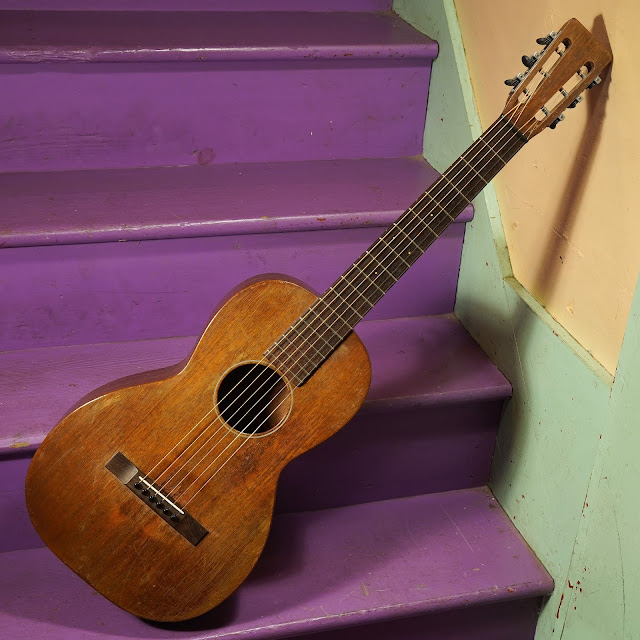1930 Martin 2-17 Parlor Guitar
The 2-17 model was Martin's first "official" foray into steel-strung, Spanish-necked guitars. This one is later in the game than most with a serial placing it at 1930 as most were built in the '20s. Size 2 bodies are an inch or so narrower than the more-commonplace 0-size models and so it's a more-compact guitar than what folks expect of a "normal" parlor-size guitar at 13" across the lower bout.
Like other same-period Martins, these are very lightly x-braced and so won't take a ton of tension. Because of that, though, they sound gorgeous. I have 46w-10 extra-lights on it right now but I imagine it could take 11s just fine. I like a Martin like this for fingerpicking but they do flatpicking well, too, though perhaps they're not the best for a heavy-handed strummer. Light strummers or "nuance" pickers will have no problems, but this is not a rock-n-roll guitar, folks.
Being a 17-series instrument, it has solid mahogany throughout its body and top and the appointments are well-done but Spartan. Before it got here for consignment a lot of good work had been done, but I "iced the cake" and ironed-out the rough edges to get it playing its best. It plays spot-on and fast and is stable and ready to go.
The old work included a neck reset, board plane and refret with new bar frets, a replacement vintage-style (but drop-in-saddle) bridge, and install of an oversized maple bridge plate. That last bit will get collectors looking askew at it, but it's often necessary on 12-fret Martins of this period because they often wind-up with top damage that makes a "fault line" in the top when the bridges pull-up over time and "dome" the top with warp. I've seen it so many times now that it's not surprising at all to me to find an oversize plate inside because... it's doing the job of keeping the top stable and safe. There's a reason Martin continually thickened their braces over the years.
My fresh work was glorified setup stuff plus the addition of repro-style tuners and better pins. It came to me with some slightly-sad replacement hardware.
Repairs included: (previously, be someone else) a neck reset, refret with bar frets, replacement bridge sand saddle, oversize bridge plate. Fresh repairs by me include a fret level/dress, saddle compensation/adjustment, new "relic" StewMac tuners, and new ebony pins throughout.
Top wood: solid mahogany
Back & sides wood: solid mahogany
Bracing type: x
Bridge: rosewood
Fretboard: rosewood
Neck wood: mahogany
Action height at 12th fret: 3/32” bass 1/16” treble (fast, spot-on)
String gauges: 46w-10 extra lights
Neck shape: medium soft V
Board radius: ~12"
Neck relief: straight
Fret style: medium-taller
Scale length: 24 7/16"
Nut width: 1 13/16"
Body width: 12 1/8"
Body depth: 4"
Weight: 2 lbs 9 oz (really!)
Condition notes: the finish has a ton of weather-check and finish hairlining everywhere. It's definitely been played and brought all over the place. There are minor scratches throughout but, ya know, it looks distinguished. There's discoloration around the bridge... but there's also mild discoloration all over the place, heh heh. The bridge, saddle, pins, and tuners are all replacements. I think the nut is, too, and the frets as well. The original bridge plate appears to be capped with a larger, wider maple one. Otherwise it's original. I like that the guy working on it last used a drop-in saddle for easy action adjustments. I'd do the same -- the original through-saddle style mount was troublesome at best because the front wall of the bridges often blows-out on them. The top shows a hair of belly (pictured) but it's a lot less than your average '50s or '60s Gibson or Martin, hah hah. The only crack I've found on the guitar is a tight, 1 1/2"-ish hairline on the back that's been glued-up and is not obvious.
It comes with: a good, newer hard case.























Comments